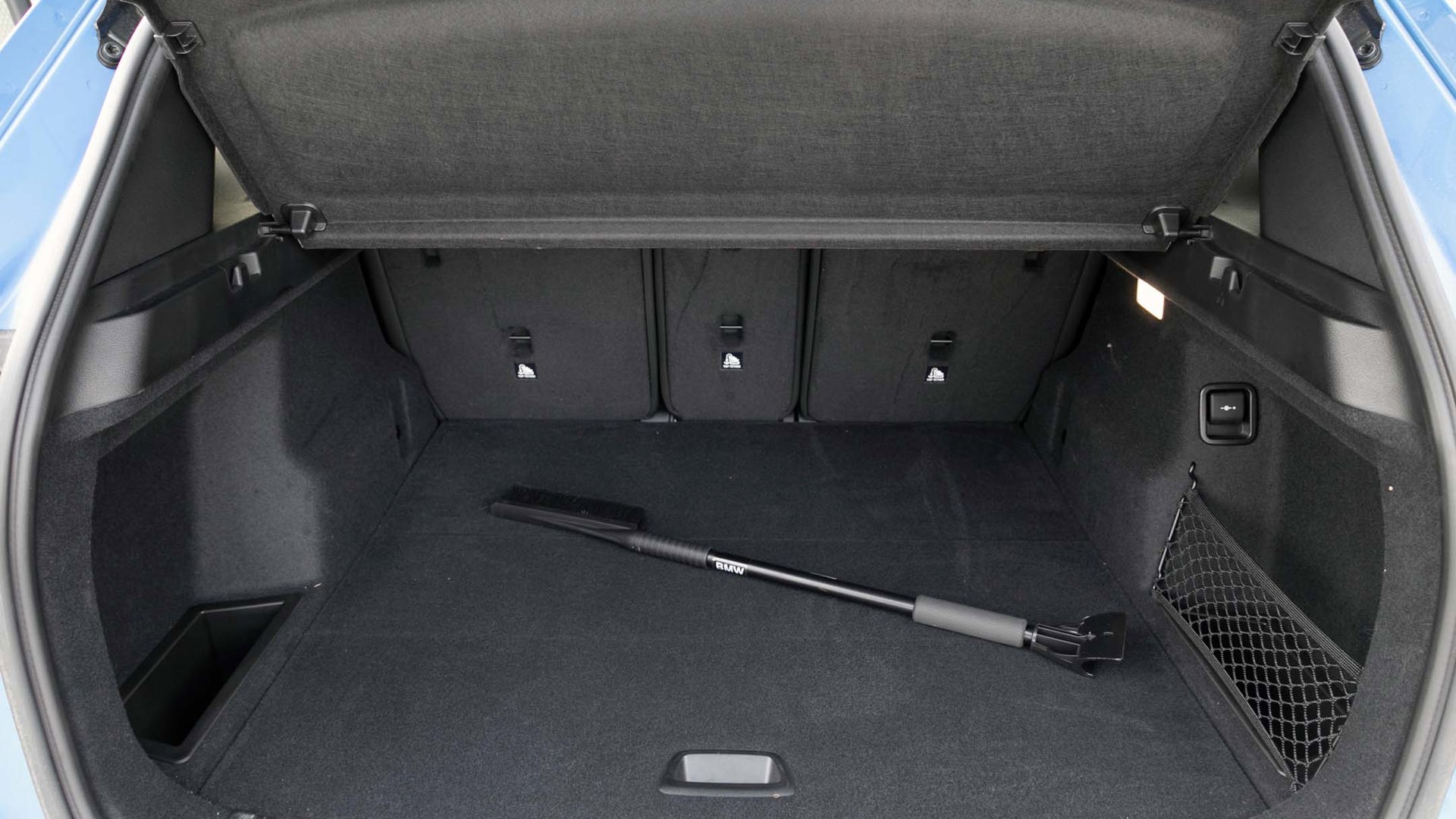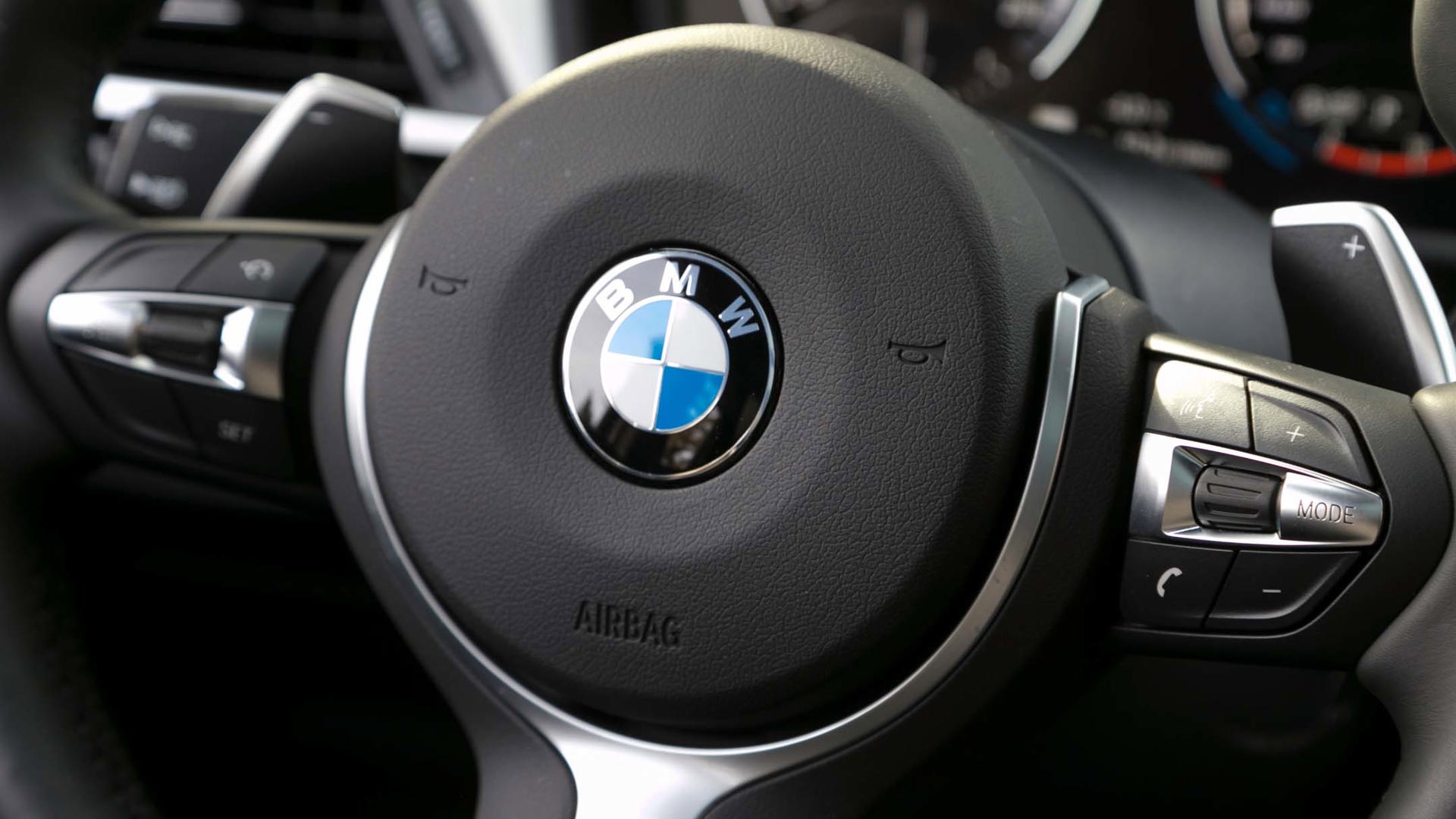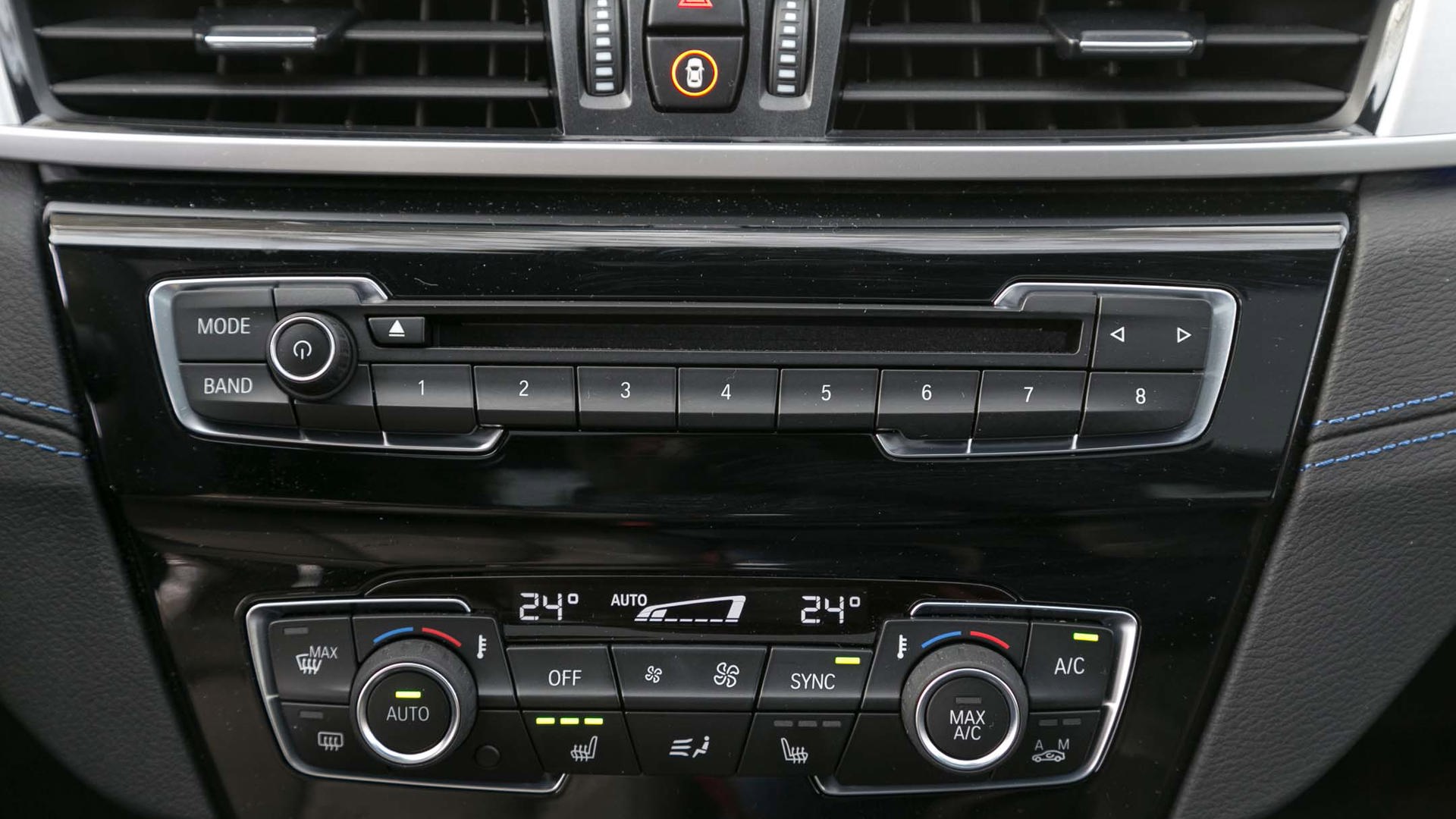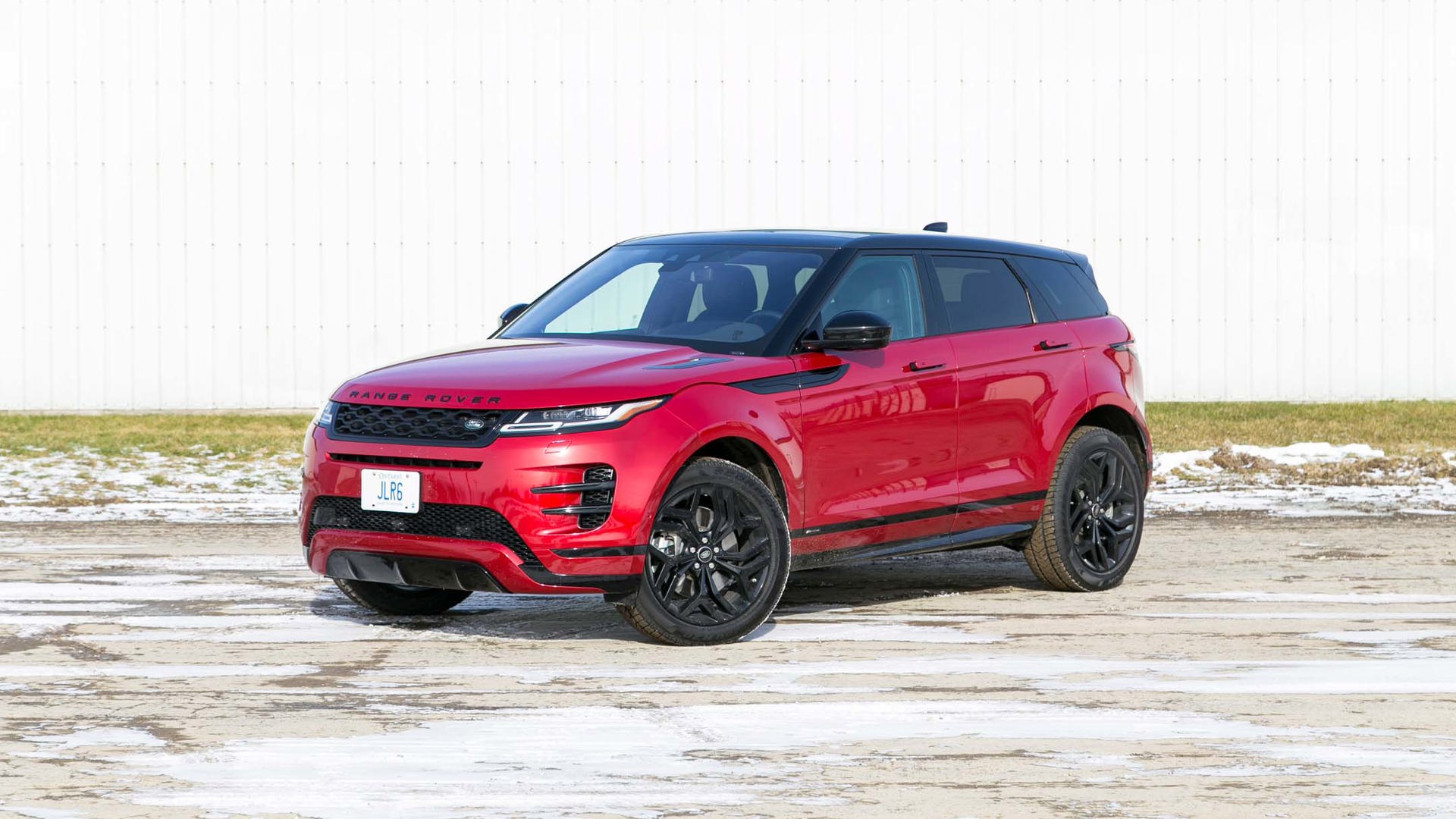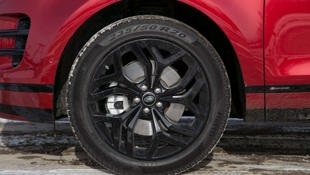Comparison Data
|
2020 BMW X1 xDrive28i
|
2020 Land Rover Range Rover Evoque R-Dynamic HSE
|
|---|---|
|
Engine Displacement
2.0L
|
2.0L
|
|
Engine Cylinders
Turbocharged I4
|
Turbocharged I4
|
|
Peak Horsepower
228 hp @ 5,000 rpm
|
296 hp @ 5,500 rpm
|
|
Peak Torque
258 lb-ft @ 1,450 rpm
|
295 lb-ft @ 1,500 rpm
|
|
Fuel Economy
10.3/7.7/9.1 L/100 km cty/hwy/cmb
|
11.4/8.9/10.3 L/100 km cty/hwy/cmb
|
|
Cargo Space
767 / 1,662 L seats down
|
612 / 1,430 L seats down
|
|
Base Price
$42,100
|
$61,500
|
|
A/C Tax
$100
|
$100
|
|
Destination Fee
$2,480
|
$1,700
|
|
Price as Tested
$55,225
|
$72,150
|
|
Optional Equipment
$10,545 – Premium Package Enhanced, $5,950; M Sport Package, $2,250; 19-inch wheels, $500; Dakota Leather, $950; Metallic Paint, $895
|
$8,850 – Satellite Radio, $500; Meridian Sound System, $600; 20” wheels, $500; Head-up Display, $1,000; Panoramic Roof, $1,300; Illuminated Treadplates, Front, $300; Power adjusted steering column, $510; Headlight Washers, $200; Cold Climate Package, $670; Black Pack, $670; Black Contrast Roof, $500; Surround Camera, $800; Massage Seats, $1,300
|
It wasn’t supposed to happen this way. The plan was to pit the all-new 2020 Range Rover Evoque against its most appropriate competitor: the 2020 BMW X2. The parallels are especially pertinent now that the Bavarians have added some extra spice to their stylish, compact sport utility vehicle, with the M35i variation pushing out 302 hp.
Unfortunately, BMW wasn’t able to supply us with an X2, proffering an X1 instead. And in truth, it isn’t an unreasonable substitute considering how closely related the two X models are mechanically. But the Evoque is much costlier than the X1, leading to questions of whether or not the British ute delivers enough to justify its price premium over the relatively affordable BMW.
Styling
Not long ago, the X1 was the runt of BMW’s sport utility lineup, looking like a low-rent version of the X3. The current generation is properly premium and, for 2020, sports enough styling updates (headlights, bumpers, side skirts and, of course, larger grille openings) to keep it fresh in the segment and clearly part of the BMW family. The new-for-2020 Misano Blue paint is Smurf-tacular, too.
The Evoque’s best feature and selling point is its looks. The first-generation Evoque was a funky, stylish little moon buggy, but this second-gen. model is a more mature version, drawing plenty of inspiration from its larger Velar sibling – arguably one of the best-looking sport utility vehicles of all time.
With its tall beltline, squat and sloping greenhouse, high contrast between the black trim and wheels, and the deep Firenze Red paint, the Evoque’s design is sporty and sexy at the same time.
Inside, it’s much the same, with contrasting red and black leather covering almost everything that’s not accented with aluminum or gloss-black trim. The dashboard is fashionable with its brightly lit glass screens.
The X1’s interior will be instantly recognized by BMW fans, but compared to the Rover, it looks severe, dour, and a little dated.
X1: 7.5
Evoque: 9
User Friendliness
The Range Rover’s evocative styling is an example of form dramatically overshadowing function. The exterior door handles retract into the bodyside, leaving smooth, stylish lines down the flanks, but on a cold, icy morning during our test, the driver’s door handle got stuck not quite in, not quite out, and largely useless.
Similarly, inside, when not switched on, the primary navigation screen lies flat against the dash, but pivots up for easier viewing when turned on. It’s a slick fashion trick, but it’s needlessly complex and makes us wonder how long it’ll last before it fails.
The screen itself is bright and crisp and easy to navigate, as are the digitized gauges in front of the driver, but the large touchscreen to control everything from climate to seating comfort is fiddly and all the touchscreens suffered from lag occasionally, being slow to respond to finger prods.
BMW’s row of lookalike black buttons, and simple small dials for volume, tuning and temperature control are easy to find and use when driving, and look similar to the systems the company has been using for decades.
BMW’s iDrive controller is a familiar tool these days after decades of refinement, and the screen, while smaller than the Evoque’s and protruding from the dash top, is within easy sight and offers touch control, too.
Simplicity equals usability and for that, the BMW earns the points here.
X1: 8
Evoque: 6
Comfort
Our X1 was fitted with the M Sport Package, which includes BMW’s highly adjustable and aggressively bolstered sport seats. With the leather stretched taut over the foam, the Bimmer’s seats are very firm and my driving partner complained about them not suiting her. Heated and perforated, the X1’s seats are not ventilated.
Not only are the Evoque’s front seats heated and cooled, but optioned as ours was, they’re also massaging. When sitting up front, there’s no question that the Range Rover is the preferred place to be, but unsurprisingly, the rear seat is confined and claustrophobic compared to the BMW’s, with less space afforded to heads, hips, and legs.
X1: 7.5
Evoque: 7.5
Practicality
Compact SUVs are supposed to offer greater functionality and usefulness than compact sport sedans, and given their ground clearance and hatchback formats, both the X1 and Evoque do exactly that. But the sexier styling of the Range Rover comes at the cost of practicality and despite being dimensionally very similar to the BMW, it offers less space for people and stuff.
The X1’s cargo hold will swallow up 767 L versus the Evoque’s 612 L with the rear seats up, and 1,662 L versus 1,430 L with them folded.
It should be noted that both SUVs have 40/20/40-split rear seats that maximize flexibility.
X1: 8
Evoque: 7.5
Features
It’s the features department where the Range Rover should start pulling away from the BMW given its cost, but here, too, it’s a tighter race than it should be. Upgraded audio systems and pretty interior LED lights are found in each SUV, and both have panoramic sunroofs, although the Range Rover’s is just an enormous piece of glass, whereas the BMW’s opens to allow in some fresh air. Both boast gesture-control liftgates and have head-up displays that are rendered useless by polarized sunglasses.
They both offer Apple CarPlay, but the BMW’s is a wireless connection that means the driver can keep their phone in their pocket or bag and still have full functionality through the infotainment system.
Conspicuously, our X1 wasn’t fitted with the optional $1,000 Driving Assistant Plus package that includes adaptive cruise control, so that’s one area the Rover trumps the Bimmer, but otherwise, unless you place significant value on having more interior surface area covered by leather, the Evoque doesn’t offer much more.
X1: 7
Evoque: 7.5
Power
If the Range Rover was playing fair, it would have come equipped with the base powertrain – a 2.0L turbocharged four-cylinder that doles out 246 hp. That’s a figure that’s reasonably competitive with the X1’s 228 hp. Instead, our Evoque was an R-Dynamic edition that benefits from a mild hybrid system, giving the little four-cylinder turbo an extra kick up to 296 hp.
While the X2 can be specified in M35i trim with 302 hp, the X1 comes only one way with its significantly less powerful 2.0L turbo.
Both machines deliver power to all four wheels via automatic transmissions. BMW continues to use the venerable ZF-sourced eight-speed gearbox – a transmission Land Rover utilized once upon a time – versus the Evoque’s nine-speed.
The BMW’s gearbox is well-matched to its engine’s powerband, tuned for lightning-quick shifts when in Sport mode, and smooth ones in Comfort, compared to the Rover’s sometimes sloppy shift behaviour.
The X1’s engine is torquey, with its peak 258 lb-ft coming on by only 1,450 rpm. The Evoque still has significantly more torque – 295 lb-ft – but since the Evoque is nearly 200 kg heavier than the leaner X1, on-road acceleration feels surprisingly close.
The Evoque is surely quicker by the measure of a stopwatch, but the BMW is a lively performer in its own right, reinforcing the urban legend that the company typically underrates its engine output figures, sometimes by a significant margin. And while both engines sound like angry vacuums when pressed hard, the BMW sounds slightly sportier, if that sort of thing matters to its buyer.
X1: 7.5
Evoque: 8
Driving Feel
Just as the BMW’s acceleration feels lively thanks to its lighter mass, its handling and braking are also surprisingly nimble. With its adaptive suspension set in Sport mode, the frisky X1 is much happier and more fun when driven hard through the corners.
The Evoque is no slouch in the handling department, but despite being shorter, wider, and riding on a longer wheelbase, the Range Rover feels larger and clumsier than the BMW when pressed to perform. In fairness, the Evoque also meets Range Rover’s corporate mandate for off-road capabilities that the BMW isn’t saddled with, even if neither one of these machines is likely to ever see anything more rugged than a rough gravel road.
R-Dynamic Evoques ride on 20-inch wheels that have precious little tire sidewall, and contribute to some nasty crashes over potholes and frost heaves. The X1’s 19-inch wheels aren’t much better, and even with the suspension set to Comfort, the ride is surprisingly firm. Don’t let the premium nameplates fool you: These two SUVs lean much more toward sporty rides than supple ones.
X1: 7.5
Evoque: 7
Safety
Each of these SUVs offers enough handling and braking capability to help drivers avoid bad situations, but in the event of a mishap, both are built with the latest crash survival structures and lots of airbags.
The Range Rover is also full of the active safety features most consumers are expecting to find in new vehicles these days, but the BMW is lacking the adaptive cruise control with stop-and-go traffic assist found in the Evoque, and a lane-keeping assistant.
Both have bright LED headlights with automatic high-beams, along with autonomous braking functionality in panic situations, and lane-departure warning systems.
X1: 7
Evoque: 8
Fuel Economy
Land Rover’s decision to add the mild hybrid system to the Evoque R-Dynamic was for performance improvement instead of fuel efficiency. Rated at 11.4 L/100 km city, 8.9 highway, and 10.3 combined, the Rover’s consumption of premium unleaded is decent, if not outstanding.
The BMW, at 10.3 L/100 km city, 7.7, highway and 9.1 combined, is better than the Evoque despite having fewer gears in its transmission and no hybrid system in play.
X1: 7.5
Evoque: 7
Value
BMW’s X1 starts at just over $42,000, and optioned up significantly as ours was, it rang in at $52,645. The Evoque R-Dynamic HSE we drove was also optioned up with $10,000 in extras, but its price sheet topped $70,000.
In fairness, a base model Evoque starts at $48,000, but that’s without the mild-hybrid powertrain, and the lavish interior that our tester had.
Still, a potential buyer would need to really love the Evoque to want to spend that much money on one, especially with so many other premium choices at that price point – many of which (like BMW’s X2 M35i, or even an X3 M40i) offer superior performance and practicality for the money.
This $52,000 X1 feels like good value on its own, but compared to the Evoque that’s $20,000 more, it’s a great value.
X1: 7
Evoque: 5
The Verdict
The Range Rover Evoque R-Dynamic looks sensational inside and out, dressed to the nines with fancy finishes and some gimmicky touches. It’s a competent machine on the road with the promise of decent off-road prowess too. To get the Evoque to compete dynamically with BMW’s X1, it becomes a very costly machine.
The BMW X1 is a functional, good-looking and legitimately fun-to-drive compact SUV that could benefit from a bit more luxury. But at just over $50,000, it’s a solid value and the better choice of these two.

















